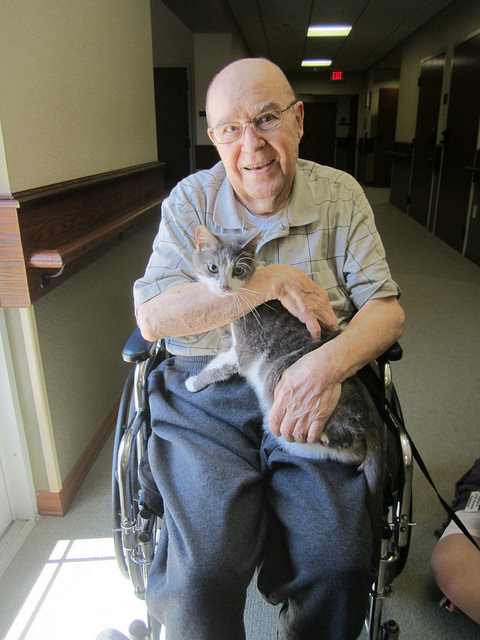Dogs get most of the credit for being therapy animals, but cats can do a great job too (and rabbits and horses, for that matter)! It takes a special kind of cat to do therapy work, and if your cat is a good fit for a certification program she can change a lot of lives with her patience, sweetness, and love. If you think your cat has what it takes to be a therapy animal (great!), here’s how to get started.
Make sure your cat meets the basic requirements
Temperament is the most important factor when it comes to therapy cats. In addition to an easy-going personality, your cat must be at least one year old and have lived in your home for at least six months. These requirements will ensure that your cat has fully matured into a predictable personality and that you will have a well established and mutually trusting relationship.

Image Source: Ann via Flickr.com
Consider training and membership fees
The work you and your cat will do will be on a volunteer basis, but it won’t be free to get trained and certified. Be prepared to pay fees that will help your instructor (who will also be a volunteer) cover the costs of text books, materials, and a venue rental. These costs will vary depending on your location. Once you’re certified, you’ll be required to pay membership fees to remain actively registered.

Get up to date on vaccinations and schedule regular wellness exams
You and your cat will be visiting a variety of facilities like schools, hospitals, and nursing homes. You’ll inherently be working with people who have compromised immune systems and will want to make sure you’re both in tip-top shape so everyone stays as healthy as possible. You’ll need to present your cat’s medical records and proof of vaccination before becoming certified.

Image Source: Jimee, Jackie, Tom & Asha via Flickr.com
Don’t feed your cat a raw food diet
Therapy animals cannot be fed raw food diets, for the same reason they must be up to date on vaccinations. Raw food diets substantially increase your cat’s chances of carrying dangerous bacterias or parasites into environments of immune compromised people.

Image Source: Last Hero via Flickr.com
Find a feline training program
There are two organizations that train and certify therapy cats. Visit Pet Partners and Love on a Leash to read about each program to see which is best for you and your cat. The Pet Partners website is particularly informative with a quiz that’ll help you decide whether or not your cat would make a good therapy animal and several informative videos about the process.

Image Source: Raul A. via Flickr.com
Become a Certified Therapy Team
Your cat isn’t the only one who will be getting certified when you enter into a training program. You and your cat will become a Certified Therapy Team and will be learning how to do the work together. Training sessions will usually take place in-person with a volunteer from the organization you choose, but they may occasionally happen online. Either way, you and your cat will be required to pass an in-person exam with an evaluator. Once you pass the exam, you’ll enter into a probation period where you and your cat will do supervised visits at facilities before you’re left on your own.
Becoming certified and registered through one of the training programs will provide you with liability insurance, give you support, and allow you to access valuable resources and information to improve the important work you and your cat are able to do.
